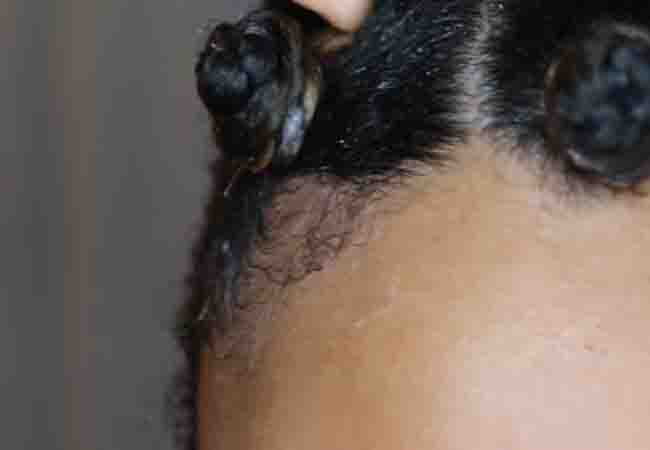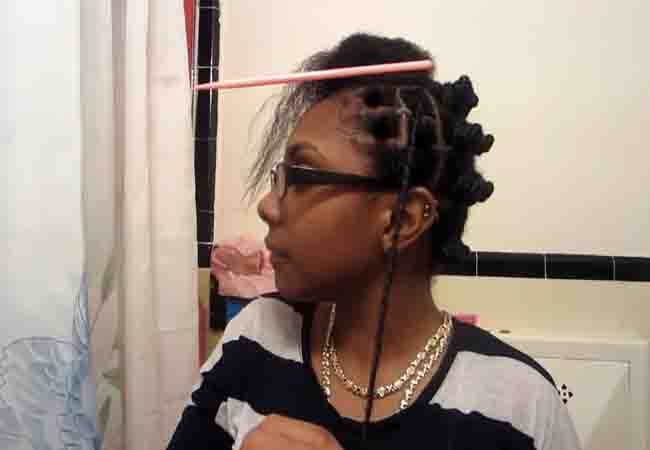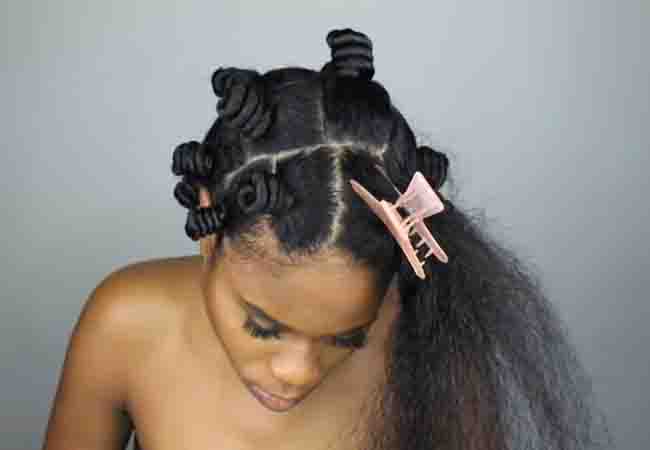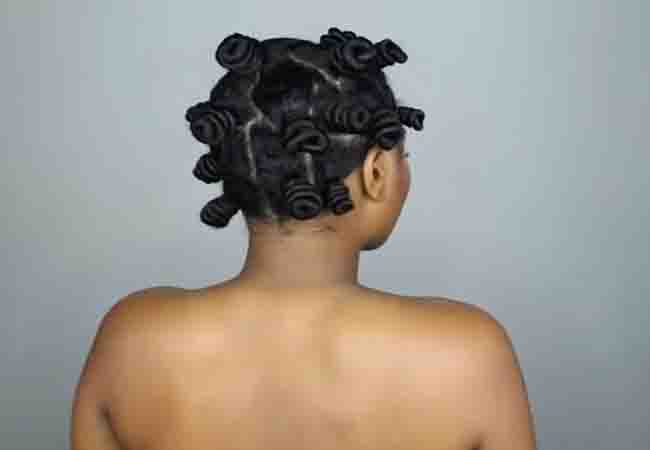On top of being heatless, Bantu knots are convenient and a great protective hairstyle. But are Bantu knots better on wet or dry hair? Based on a three-week experiment, we’ve gathered some evidence about which state is the best for tying the knots.
Stick to the end to find out.
Bantu Knots On Wet Hair

Making Bantu knots on wet hair is super fast and easy. Moreover, if you use wet hair you’ll have a grip on twisting the knots.
However, making Bantu knots on wet hair can be troublesome, as it takes the longest time to dry. On top of that, if you keep the wet knots overnight, you’ll catch a cold.
Sometimes, a putrid smell develops if your hair is wet for too long.
Knotting on wet hair is best for slippery coiled twists. Be sure to deep condition first. The curl patterns will look great on your dark hair.
Bantu Knots On Damp Hair

According to experts, damp hair is the best for tying Bantu knots. Even the general consensus is that it’s easier to make the knots with damp hair as it remains hydrated enough.
Dampness keeps the hair moist, so it’s easier to make the twists. Moreover, the hair won’t pull on your scalp, so you’ll feel less irritation. Even untwisting the braids are easier as the curls remain soft and smooth.
You can make your hair damp by lightly spraying water before twisting the knots. Apply hair serum to lock your hair’s moisture which will help to keep it damp for more extended periods.
Bantu Knots on Dry Hair

Bantu knots are a great way to style your dry hair. They are easy to do and can be done on any type of hair. You can use them to create various looks, from a sleek and polished updo to a fun and funky style.
Dry hair is the best fit for Bantu knots if you don’t have much time to spare. They take the shortest time to dry, so you get instant curls quickly.
However, dry hair can cause discomfort and irritation. Dehydrated hair will make your scalp itchy. On top of that, the results won’t be as smooth or shiny. In fact, dry hair is more likely to produce dull and rough curls.
It’s better to use hair cream or spray some water when working with dry hair.
What is the Best Method for Applying Bantu Knots on Wet, Damp, or Dry Hair?

After the three-week experiment of making Bantu knots with three different states of hair, you’ll see that damp hair produces the best results. Nevertheless, dry hair and wet hair have got some merits too.
But what makes damp hair the best fit for making Bantu knots? Damp hair is neither too dry nor completely wet; it’s the perfect balance between the two. The hair texture is slippery enough to tie knots smoothly while being parched enough to hold the knots in place.
However, making Bantu knots with dampened hair has some drawbacks as well. If you have a scalp infection, it’s better not to keep your hair damp for long hours. Sometimes, using chemicals on damp hair can release a bad smell.
But, even considering the demerits, damp hair is a far better choice for making Bantu knots than dry or wet hair.
While dry hair can hold the knot’s shape better, it often causes irritation, making the end look stiff and rough. On the other hand, it’s pretty challenging to manage wet hair, and it takes more time to dry.
How Do You Refresh Bantu Knots
To refresh your Bantu knots, do the following:
- Spray water or a mixture of water and oil to loosen your curls.
- Undo each knot.
- Use a wide-tooth comb to detangle your curls.
- Redo your knots with a light-hold gel or mousse.
Do Bantu Knots Help Hair Grow
Bantu knots help promote hair growth by protecting your hair from breakage, tension and pulling.
But since hair growth is primarily determined by genetics, diet, and stress level, it can’t be said that having Bantu knots alone will help grow hair faster.
Do You Sleep with Bantu Knots
While it’s okay to sleep with Bantu knots, it’s better to ensure that your hair is protected when doing so. To ensure that your hair won’t be damaged when you sleep with Bantu knots installed, wear a silk or satin scarf, or sleep on a satin pillowcase.
Can Bantu Knots Damage Hair
When done with proper care, Bantu knots don’t cause hair damage.
But hair damage is possible when the knots are done too tightly or if your hair is not thoroughly moisturized.
Another thing to remember is that if your hair is not detangled properly before getting the knots installed, it can get matted.
Can I Use Conditioner for Bantu Knots
Yes, conditioners might be one of the best products you can use on your Bantu knots. Using a moisturizing conditioner before installing your knots will help keep your hair moisturized and mitigate the chances of it becoming dry,
Can I Use Mousse for Bantu Knots
Applying mousse on Bantu knots can help keep them in place, make them look more defined, and enhance curls while preventing frizz.
Put some mousse on slightly damp hair and style before or after getting your knots done. Try to avoid mousse with alcohol, as that might dry your hair out.
What Products to Use on Bantu Knots
When choosing products for your Bantu knots, look for products that’ll provide moisture and nutrition and hold to your knots. You can use products such as:
a. Leave-in Conditioner
A leave-in conditioner, like the SheaMoisture Jamaican Black Castor Oil Leave In Conditioner, will provide moisture and keep your hair hydrated throughout the day while keeping it detangled without weighing it down.
b. Light Hold Product
A light hold styling product, like the Kenra Shine Spray, will help hold your knots in shape and enhance your curls.
c. Hair Mousse
A hair mousse formulated for knots, such as the L’Oreal Paris Hair Care Advanced, will help hold the knots in place and make them look more defined while also preventing frizz.
How Do You Moisturize Your Hair with Bantu Knots
To moisturize your hair while wearing Bantu knots, do the following:
- Cleanse your hair with a sulfate-free shampoo and then deep condition it.
- Detangle your curls with a wide-tooth comb.
- Put a leave-in conditioner after cleaning your hair for extra moisture.
- Use a light oil or hair butter to lock moisture into your hair and add shine to it.
- Use a satin or silk scarf at night to keep moisture in your hair while you sleep.
How Do You Fluff Out Bantu Knots
Do the following if you want to fluff out your Bantu knots:
- Spray water on your hair to loosen your curls.
- Use a wide-tooth comb to unravel your knots.
- Fluff out your curls using your fingers.
- Re-do your hair in your preferred pattern.
- Use a light-hold hair product to secure it in place.
How to Do Perfect Bantu Knots
The steps below are instructions on how to do the perfect Bantu knots:
- Clean your hair and scalp with a sulfate-free shampoo and deep condition with a moisturizing conditioner.
- Detangle your hair with a wide-tooth comb.
- Divide your hair into sections to tie your knots easily
- Twist each section until they start coiling into themselves.
- Use a light-hold gel or spray to stick the knots into place.
- To keep the knots in place, wear a silk or satin scarf when going to bed.
How Often Should I Do Bantu Knots
How often you should do your Bantu knots depends on your hair type, the health of your hair and scalp, and what styles you prefer.
Remember that doing Bantu knots too often can cause tension and pull on your hair, which might lead to hair breakage.
A general rule of thumb you can follow is to wait for at least a week and ensure that your hair is properly moisturized before getting your Bantu knots re-done.
How Long Should Bantu Knots Stay In
It’s better not to leave your Bantu knots in for more than two weeks. But that is only when you can ensure absolute care of your hair and scalp while you have the knots.
If you fail to do so, the build-up will start accumulating on your scalp and your hair will start breaking.
FAQs
How long do Bantu knots take to dry?
Bantu knots can take 5-7 hours to dry. The time depends on your hair length and whether it’s wet or dry. But it’s best to dry the knots overnight to get a perfect spiral effect.
Can I make Bantu knots with short hair?
Long hair is better for making Bantu knots, as short hair can’t make as many twits and hold the shape of the knot.
How to damp my hair to make Bantu knots?
You can dampen your hair by spraying water while making the Bantu knots. Applying serum or hair cream will keep your hair moist and produce a glossy effect.
Verdict
So, are Bantu knots better on wet or dry hair? Technically, you can make the knots on either of them, but to get the best results, you should opt for damp hair.
Damp hair is proven to be the best for Bantu knots not only during our 3-week experiment, but hairstyle experts also acknowledge it.

